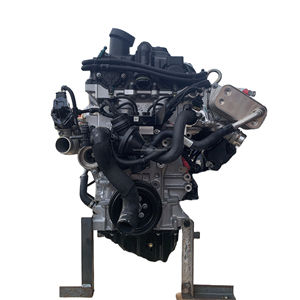Economical Opel Corsa Engine Options for Your Spending plan
Economical Opel Corsa Engine Options for Your Spending plan
Blog Article
Discovering the Inner Workings of a Compact Lorry's Engine System
As drivers, we typically take for granted the complex procedures that happen within the boundaries of our automobile's engine system. In this expedition of a compact vehicle's engine system, we will certainly unravel the internal workings of this mechanical symphony, shedding light on the secrets that drive us forward on our everyday journeys.
Burning Process Introduction
The combustion process in a compact automobile's engine system is a vital mechanism that effectively converts fuel right into energy to power the automobile. This process occurs within the burning chamber of the engine, where gas and air mix, stir up, and create controlled surges. The combustion process includes four primary stages: intake, compression, power, and exhaust.
During the consumption phase, the piston moves downward, reeling in a mix of air and gas into the combustion chamber. The following stage, compression, includes the piston relocating upward, compressing the air-fuel mix to boost its potency. Ultimately, in the power stage, the ignition system ignites the pressed mix, causing a quick expansion of gases that forces the piston back down. This down motion produces the power needed to drive the car. Lastly, in the exhaust stage, the burnt gases are eliminated from the combustion chamber with the exhaust valve, preparing the chamber for the next cycle. This cyclic burning procedure is essential to the procedure of a compact lorry's engine system, ensuring reliable power conversion for propulsion.
Piston and Cylinder Interaction

The piston's exact fit within the cyndrical tube is necessary for keeping optimum compression and preventing power loss during burning. Tight clearances between the piston and cylinder wall surfaces guarantee effective sealing, allowing the piston to move efficiently without enabling gases to leakage past. Correct lubrication is likewise crucial to decrease rubbing and wear between these elements, enhancing longevity and efficiency.
Furthermore, the style and materials made use of in manufacturing the piston and cyndrical tube effect engine performance and toughness. Modern engines frequently use lightweight yet long lasting materials like light weight aluminum alloys for pistons and cylinder linings to reduce inertia and boost thermal efficiency. In general, the unified communication in between the piston and cyndrical tube is fundamental to the engine's functionality and total efficiency.
Fuel Injection System Performance
Fuel injection systems in portable car engines play an important duty in precisely providing gas to the burning chamber for controlled and effective ignition. The fuel injection system functions by infusing fuel into the combustion chamber at the optimal moment throughout the engine's procedure (opel corsa engine). This accurate timing ensures that the fuel mixes evenly with the air for proper burning, bring about improved gas effectiveness and reduced discharges
There are mostly 2 kinds of fuel injection systems used in small lorry engines: port gas shot visit this website (PFI) and straight fuel injection (DFI) PFI systems inject fuel into the intake port prior to the intake shutoff, while DFI systems infuse gas straight right into the burning chamber. Both systems have their advantages, with DFI supplying better fuel atomization and PFI offering an extra economical option.
Recognizing Engine Air Conditioning Systems
Efficient operation of a compact car's engine counts heavily on the efficiency of its cooling devices. The cooling system in a portable automobile commonly consists of a number of components functioning with each other to control the engine temperature. Comprehending these engine air conditioning mechanisms is essential for preserving the efficiency and longevity of a portable vehicle's engine system.

Exhaust System Parts Explained
The ideal performance of a compact car's engine air conditioning devices depends upon a corresponding system called the exhaust system, which consists of various vital this contact form parts for making sure effective emissions and engine efficiency. The exhaust system consists of components such as the exhaust manifold, catalytic converter, muffler, and tailpipe. The exhaust manifold accumulates exhaust gases from the engine's courses and cyndrical tubes them to the catalytic converter. The catalytic converter then transforms unsafe toxins in the exhaust right into much less dangerous discharges prior to releasing them via the muffler and tailpipe.
One important element of the exhaust system is the oxygen sensing unit, which monitors the oxygen degrees in the exhaust gases to help control gas usage and ensure optimum engine performance. opel corsa engine. In addition, the resonator might exist in some exhaust systems to lower noise degrees. On the whole, the exhaust system plays an essential function in keeping engine efficiency, reducing harmful exhausts, and ensuring a quieter driving experience for small lorry proprietors

Conclusion
To conclude, the compact car's engine system is an intricate combination of elements that interact to promote the burning process, convert fuel right into energy, and remove waste gases. Understanding the inner workings of the engine system, consisting of the piston and cyndrical tube interaction, gas shot system, engine air conditioning mechanisms, and exhaust system elements, is essential for keeping ideal efficiency and effectiveness of the automobile.
The combustion procedure in a portable car's engine system is an important device that effectively transforms fuel into power to power the lorry.Fuel injection systems in portable automobile engines play a vital function in exactly providing fuel to the burning chamber for controlled and reliable ignition.There are primarily two kinds of fuel injection systems made use of in compact lorry engines: port gas injection (PFI) and straight go to this web-site gas shot (DFI) Comprehending these engine cooling systems is important for keeping the performance and durability of a portable automobile's engine system.
The optimum performance of a small automobile's engine cooling mechanisms depends on a complementary system understood as the exhaust system, which comprises different crucial parts for guaranteeing efficient discharges and engine efficiency.
Report this page